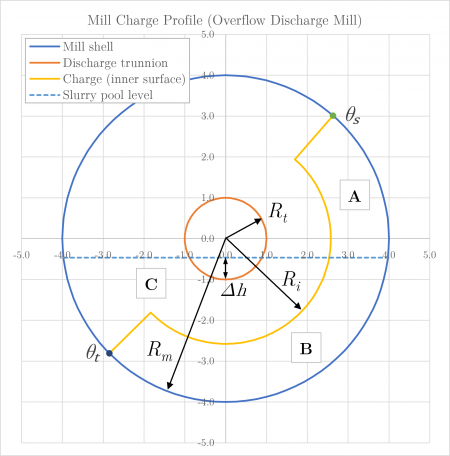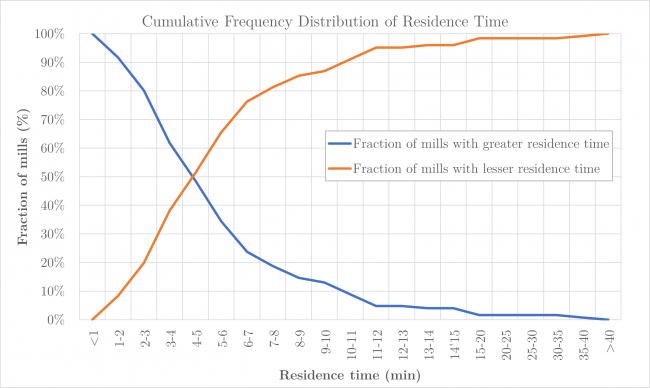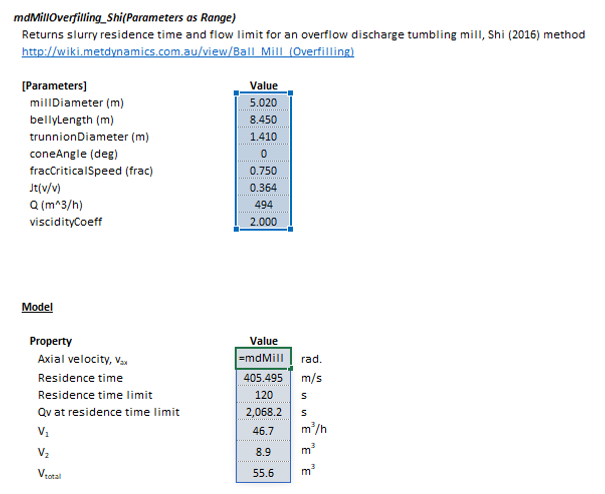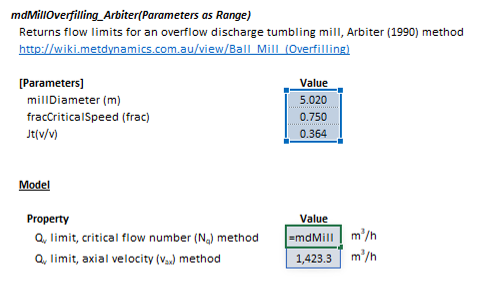Description
This article describes several methods for estimating the maximum volumetric flow capacity of an overflow ball mill, including the Shi (2016) and Arbiter (1991) approaches.[1][2]
Model theory
Shi method

Figure 1. Overflow discharge tumbling mill profile showing Shi's assumed charge and slurry pool areas.
Shi (2016) estimated the residence time of an overflow ball mill by considering the volume of slurry present in the grinding media interstices and slurry pool.
This was accomplished by adopting Morrell's (1996) simplified charge geometry and calculating the volume of slurry resident in each of the areas A-C in Figure 1:[3]
- A. In the grinding media interstices above the slurry pool level
- B. In the grinding media interstices below the slurry pool level
- C. In the slurry pool
The total volume of slurry in the mill is therefore the sum of slurry in areas A-C.
Estimating the slurry volume in areas A-C requires definition of the simplified charge geometry and slurry pool level for the mill in question.
Charge position
The simplified charge geometry is defined by three parameters:
- the angular position of the toe of the charge,
 (rad),
(rad),
- the angular position of the shoulder charge,
 (rad), and
(rad), and
- the radius of the inner charge surface,
 (m).
(m).
Morrell's equations are used to define the charge position, i.e.[3]
The position of the toe of the charge is defined as:

where:
 is the volumetric fraction of the mill occupied by balls and coarse rock (including void space and interstitial slurry) (v/v)
is the volumetric fraction of the mill occupied by balls and coarse rock (including void space and interstitial slurry) (v/v) (frac) is the theoretical fraction critical speed.
(frac) is the theoretical fraction critical speed.
The fraction of critical speed at which centrifuging actually occurs,  (frac), is:
(frac), is:

The position of the shoulder of the charge is:
![{\displaystyle \theta _{\rm {s}}={\frac {\pi }{2}}-\left(\theta _{\rm {t}}-{\frac {\pi }{2}}\right){\big [}\left(0.336+0.1041\phi \right)+\left(1.54-2.5673\phi \right)J_{\rm {t}}{\big ]}}](https://wikimedia.org/api/rest_v1/media/math/render/svg/f05377424ef722f6387e782b571b4442f0707f5b)
The inner charge surface radius is:

where  is the radius of the mill (m), and the fraction of total charge in the active region,
is the radius of the mill (m), and the fraction of total charge in the active region,  (frac), is:
(frac), is:

The time taken to travel between the toe and shoulder of the charge during one revolution,  (s), is:
(s), is:

where the mean rotational rate,  (rev/s), is:
(rev/s), is:

and  is the rotational rate of the mill shell (rev/s).
is the rotational rate of the mill shell (rev/s).
The time taken to travel between the shoulder and toe of the charge in free flight during one revolution,  (s), is:
(s), is:

where the mean radial position  (m), is:
(m), is:
![{\displaystyle {\bar {r}}={\frac {r_{\rm {m}}}{2}}\left[1+\left(1-{\frac {2\pi J_{\rm {t}}}{2\pi +\theta _{\rm {s}}-\theta _{\rm {t}}}}\right)^{0.5}\right]}](https://wikimedia.org/api/rest_v1/media/math/render/svg/ba1b005d4cbc2ad5d5445dc1e90980edf7f7c679)
Slurry hold-up below pool level
The volume of slurry held up below the pool level in areas B and C,  (m3), is:
(m3), is:

where:
 is effective mill length (m)
is effective mill length (m) is cross-sectional area of the slurry pool (m2)
is cross-sectional area of the slurry pool (m2) is cross-sectional area occupied by the grinding media, excluding balls, below the slurry pool level(m2)
is cross-sectional area occupied by the grinding media, excluding balls, below the slurry pool level(m2)
This implementation of the Shi model computes  as an effective mill length from:
as an effective mill length from:

where  is the volume of the mill (m3) and
is the volume of the mill (m3) and  is the radius of the mill (m).
is the radius of the mill (m).
The volume of the mill is calculated as the sum of a cylinder and two right circular frustums:[4]
![{\displaystyle V_{\rm {m}}=\pi {R_{\rm {m}}}^{2}L+2\cdot {\bigg [}{\dfrac {\pi }{3}}(R_{\rm {m}}-R_{\rm {t}})\cdot \tan \alpha _{\rm {c}}\cdot \left({R_{\rm {m}}}^{2}+R_{\rm {m}}R_{\rm {t}}+{R_{\rm {t}}}^{2}\right){\bigg ]}}](https://wikimedia.org/api/rest_v1/media/math/render/svg/c2b0a3462f6a77ffb5709a4cc61d060e59c69ddc)
where:
 is the length of the cylindrical (belly) section of the mill (m)
is the length of the cylindrical (belly) section of the mill (m) is the radius of the discharge trunnion (m)
is the radius of the discharge trunnion (m) is the cone angle, measured as the angular displacement of the cone surface from the vertical direction (rad)
is the cone angle, measured as the angular displacement of the cone surface from the vertical direction (rad)
 is computed from:
is computed from:



where  is the radius of the discharge trunnion (m), and
is the radius of the discharge trunnion (m), and  is the height of the slurry pool level over the trunnion lip (m).
is the height of the slurry pool level over the trunnion lip (m).
The value of  may be estimated as
may be estimated as  , where
, where  is the slurry height above the trunnion level inside the mill (m):[5]
is the slurry height above the trunnion level inside the mill (m):[5]

and:
 is an empirical coefficient related to the viscidity of the slurry (Morrell suggests
is an empirical coefficient related to the viscidity of the slurry (Morrell suggests  , Shi applies
, Shi applies  )
) is the volumetric discharge rate of pulp from the mill (m3/s)
is the volumetric discharge rate of pulp from the mill (m3/s) is acceleration due to gravity (m/s2)
is acceleration due to gravity (m/s2)
 is computed as:
is computed as:


where the dynamic charge porosity,  (v/v), is:
(v/v), is:
![{\displaystyle \varepsilon _{\rm {d}}=0.4+0.228\left[1-\exp \left(-0.315{\dfrac {\phi }{J_{\rm {t}}}}\right)\right]}](https://wikimedia.org/api/rest_v1/media/math/render/svg/d476b09279ef151a53ba5f200c157b151c8de855)
Slurry hold up above pool level
The volume of slurry held up in the grinding media interstices above the slurry pool level in area A,  (m3), is:
(m3), is:

where:

Residence time and overfilling
The total volume of slurry hold up in the mill is  (m3).
(m3).
The residence time of slurry in the mill,  (s), is then:
(s), is then:

The axial velocity of slurry through the mill,  (m/s), is:
(m/s), is:

Shi suggests the following residence time limits for overflow discharge ball mills (s):

where  is the diameter of the mill (m), i.e.
is the diameter of the mill (m), i.e.  .
.
The maximum volumetric flow rate of the mill,  (m3/s), at the residence time limit
(m3/s), at the residence time limit  may be back-calculated using the above relations. However, as the height of slurry above the trunnion lip (
may be back-calculated using the above relations. However, as the height of slurry above the trunnion lip ( ), and hence residence time (
), and hence residence time ( ), is a function of flow rate, no analytical solution is available and a numerical method is required for computation.
), is a function of flow rate, no analytical solution is available and a numerical method is required for computation.
Arbiter method
Based on an analysis of industrial ball mills at five operations, Arbiter (1991) postulated that the axial velocity of pulp through a mill should be less than 2.2% of the mill's tangential velocity. The Arbiter Flow Number,  , is defined as the ratio of axial to tangential velocity and is determined from:
, is defined as the ratio of axial to tangential velocity and is determined from:

where:
 is the volumetric discharge rate of pulp from the mill (m3/s)
is the volumetric discharge rate of pulp from the mill (m3/s) is the mill diameter (m)
is the mill diameter (m) is the volumetric charge fraction in the mill (v/v)
is the volumetric charge fraction in the mill (v/v) is mill rotational speed (rev/min)
is mill rotational speed (rev/min)
The Arbiter Flow Number equation may be rearranged to yield the following relation for the maximum volumetric discharge rate of slurry from a mill prior to overloading,  (m3/h):
(m3/h):

Overfilling may be a risk if the actual volumetric flow rate to/from the mill approaches or exceeds  .
.
Additional notes
Shi estimated the residence times for a database of 121 overflow ball mills. These residence times are presented as cumulative frequency distributions in Figure 2, allowing the performance a given mill to be ranked against the database.
 Figure 2. Cumulative frequency distribution of the volume-based residence time of 121 mills in Shi's database (after Shi, 2016). [1] |
Arbiter's relations were developed from a limited database of five mills, the largest of which was 5.3 m diameter x 6.4 m length.
Excel
Shi method
The Shi overflow discharge ball mill overfilling model may be invoked from the Excel formula bar with the following function call:
=mdMillOverfilling_Shi(Parameters as Range)
Invoking the function with no arguments will print Help text associated with the model, including a link to this page.
The Parameters array and model results are defined below in matrix notation, along with an example image showing the selection of the same arrays in the Excel interface:

|
 Figure 3. Example showing the selection of the Parameters (blue frame), and Results (light blue frame) arrays in Excel. |
Arbiter method
The Arbiter overflow discharge ball mill overfilling model may be invoked from the Excel formula bar with the following function call:
=mdMillOverfilling_Arbiter(Parameters as Range)
Invoking the function with no arguments will print Help text associated with the model, including a link to this page.
The Parameters array and model results are defined below in matrix notation, along with an example image showing the selection of the same arrays in the Excel interface:

|
 Figure 4. Example showing the selection of the Parameters (blue frame), and Results (light blue frame) arrays in Excel. |
SysCAD
The Ball Mill Overfilling Indicator model is an optional calculation for tumbling mill units. If selected, the input and display parameters below are shown.
| Tag (Long/Short)
|
Input / Display
|
Description/Calculated Variables/Options
|
| Overfilling
|
| HelpLink
|

|
Opens a link to this page using the system default web browser. Note: Internet access is required.
|
| Shi
|
| MillDiameter
|
Input/Display
|
Diameter of the mill (inside liners).
|
| BellyLength
|
Input/Display
|
Length of the cylindrical section (belly) of the mill (inside liners).
|
| TrunnionDiameter
|
Input/Display
|
Diameter of the trunnion (inside liners).
|
| ConeAngle
|
Input/Display
|
Angular displacement of the cone surface from the vertical direction.
|
| FracCS
|
Input/Display
|
Fraction critical speed of the mill.
|
| Jt
|
Input/Display
|
Volumetric fraction of the mill occupied by balls and coarse rock (including voids).
|
| ViscidityCoeff
|
Input
|
Coefficient of viscidity.
|
| V1
|
Display
|
Volume of slurry below slurry pool level.
|
| V2
|
Display
|
Volume of slurry above slurry pool level.
|
| V1
|
Display
|
Total volume of slurry in charge and pool.
|
| AxialVelocity
|
Display
|
Axial velocity of slurry flow through the charge and pool.
|
| tRes
|
Display
|
Residence time of slurry in mill.
|
| tLimit
|
Display
|
Shi's suggested lower limit of residence time for mill. Based on mill diameter.
|
| Feed.SLQv
|
Display
|
Volumetric flow rate of slurry (solids + liquids) in mill feed.
|
| Feed.SLQv.Limit
|
Display
|
Estimated volumetric flow rate of slurry (solids + liquids) in mill feed at tLimit.
|
| Overfilled
|
True/False
|
Indicates if tRes is less than tLimit, i.e. mill is overfilled.
|
| Arbiter
|
| MillDiameter
|
Input/Display
|
Diameter of the mill (inside liners).
|
| FracCS
|
Input/Display
|
Fraction critical speed of the mill.
|
| Jt
|
Input/Display
|
Volumetric fraction of the mill occupied by balls and coarse rock (including voids).
|
| Feed.SLQv
|
Display
|
Volumetric flow rate of slurry (solids + liquids) in mill feed.
|
| Feed.SLQv.NqLimit
|
Display
|
Estimated volumetric flow rate of slurry (solids + liquids) at Arbiters critical flow number limit.
|
See also
References
- ↑ 1.0 1.1 Shi, F., 2016. An overfilling indicator for wet overflow ball mills. Minerals Engineering, 95, pp.146-154.
- ↑ Arbiter, N., 1991. Dimensionality in ball mill dynamics. Mining, Metallurgy & Exploration, 8(2), pp.77-81.
- ↑ 3.0 3.1 Morrell, S., 1996. Power draw of wet tumbling mills and its relationship to charge dynamics. Pt. 1: a continuum approach to mathematical modelling of mill power draw. Transactions of the Institution of Mining and Metallurgy. Section C. Mineral Processing and Extractive Metallurgy, 105.
- ↑ Gupta, A. and Yan, D.S., 2016. Mineral processing design and operations: an introduction. Elsevier.
- ↑ Morrell, S., 2016. Modelling the influence on power draw of the slurry phase in Autogenous (AG), Semi-autogenous (SAG) and ball mills. Minerals Engineering, 89, pp.148-156.
 Figure 2. Cumulative frequency distribution of the volume-based residence time of 121 mills in Shi's database (after Shi, 2016).[1]
Figure 2. Cumulative frequency distribution of the volume-based residence time of 121 mills in Shi's database (after Shi, 2016).[1]








![{\displaystyle \theta _{\rm {s}}={\frac {\pi }{2}}-\left(\theta _{\rm {t}}-{\frac {\pi }{2}}\right){\big [}\left(0.336+0.1041\phi \right)+\left(1.54-2.5673\phi \right)J_{\rm {t}}{\big ]}}](https://wikimedia.org/api/rest_v1/media/math/render/svg/f05377424ef722f6387e782b571b4442f0707f5b)












![{\displaystyle {\bar {r}}={\frac {r_{\rm {m}}}{2}}\left[1+\left(1-{\frac {2\pi J_{\rm {t}}}{2\pi +\theta _{\rm {s}}-\theta _{\rm {t}}}}\right)^{0.5}\right]}](https://wikimedia.org/api/rest_v1/media/math/render/svg/ba1b005d4cbc2ad5d5445dc1e90980edf7f7c679)








![{\displaystyle V_{\rm {m}}=\pi {R_{\rm {m}}}^{2}L+2\cdot {\bigg [}{\dfrac {\pi }{3}}(R_{\rm {m}}-R_{\rm {t}})\cdot \tan \alpha _{\rm {c}}\cdot \left({R_{\rm {m}}}^{2}+R_{\rm {m}}R_{\rm {t}}+{R_{\rm {t}}}^{2}\right){\bigg ]}}](https://wikimedia.org/api/rest_v1/media/math/render/svg/c2b0a3462f6a77ffb5709a4cc61d060e59c69ddc)


















![{\displaystyle \varepsilon _{\rm {d}}=0.4+0.228\left[1-\exp \left(-0.315{\dfrac {\phi }{J_{\rm {t}}}}\right)\right]}](https://wikimedia.org/api/rest_v1/media/math/render/svg/d476b09279ef151a53ba5f200c157b151c8de855)





















